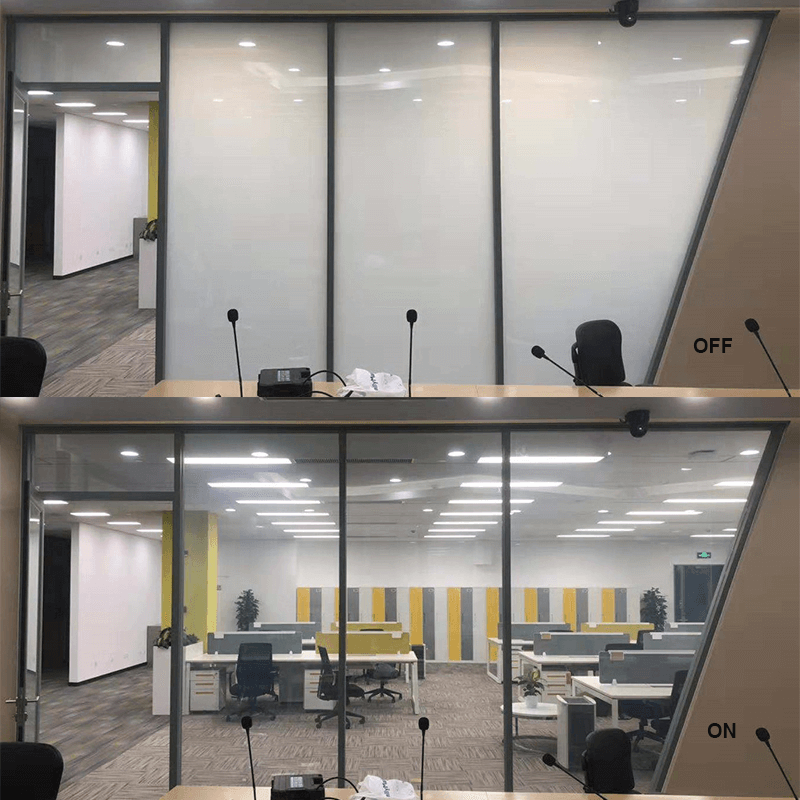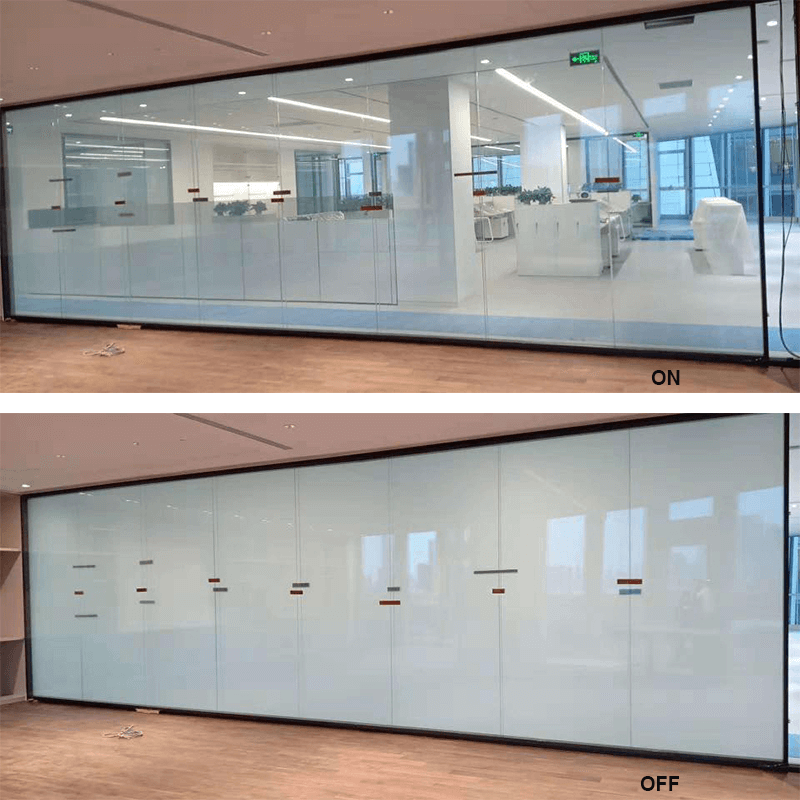How pdlc glass film Tint Electronically Opaque Glass Works?
Features and advanatges of adhesive privacy glass film pdlc

Also called ” Switchable film “, Smart film , Smartglass, Intelligent Glass Control, E-Tint , smart glass, privacy glass, magic glass … For all these names there is the same product, pdlc glass film, the system in which the laminates lose or gain opacity immediately, at the press of a button.
They are known as smart glasses for their ability to offer more benefits to the user than the transparency of ordinary glasses.
The pdlc glass film is basically a glass connected to the electrical energy can leave films visual opaque or transparent, depending on the time. If it is off, it is opaque, and can even be used as an image projection screen.
They can block sunlight and prevent overheating, reducing electricity costs by avoiding the use of air conditioning. In addition, it may also have other more advanced features, such as functioning as a home automation control panel or as a screen for rear-projection of images and videos.
What is pdlc glass film?
The PDLC smart film is based on liquid crystal technology dispersed in polymers. The smart glass film can switch between transparent and opaque by adjusting the tension. With the principle of the electric field of PDLC glass, it is convenient to protect privacy while maintaining transmittance.
Therefore, it has the double characteristics of ordinary windows and electric blinds. Therefore, pdlc glass film is widely used in conference rooms, central control rooms, hotels, etc. (These occasions require privacy). The liquid crystal darkening film can also be used as a projection screen in a frost state. It is mainly used in shopping malls and other occasions.
Dispersed liquid crystal polymers (PDLCs)
The most traditional of the three, it is a laminated glass assembled with at least:
- two glass plates
- two plastic films and
- a liquid crystal layer covered by a film covered with an energy-conducting material
For the glass to be transparent, the electric current is activated to polarize and organize the liquid crystal particles allowing the passage of light. For the glass to be opaque, the electrical current is interrupted by disorganizing the particles of the liquid crystal that spread in various directions. With that, the glass changes color instantly, becoming milky white.
Although the idea is to provide the same benefits. There are currently three most popular technologies available to the consumer:
- liquid crystal (LCD)
- electrochromic and
- suspended particulate device (SPD)
Let’s see how they work:
Electrochromic glasses – electro + chromic
Known for being the most economical, electrochromic glasses are made with materials capable of changing color when they receive an electrical discharge. They are formed by five thin pdlc glass film pressed between two glass plates.

The electricity triggers a chemical reaction in the electrochromic film of the sandwich, changing the way the glass reflects light. Depending on the substance that constitutes the device’s films, the colors obtained can be:
- blue
- green
- yellow
- red and
- gray
Also, depending on the electrochromic film applied to the glass, when activating the electric current, solar radiation can be filtered, reducing the incidence of infrared rays. To make the glass transparent, just depolarize the particles of the electrochromic device.
This glass with transparency control is a solution for division of environments that makes it possible to block or allow the view through the glass. Thanks to pdlc glass film advanced technology, which combines electricity and liquid crystal, the glass goes from transparent to opaque with a simple actuation, eliminating the need to use blinds.
But how does pdlc glass film work?
The glasses with transparency control are assembled with a film composed of liquid LCD crystals, technology of Liquid Crystals (pdlc glass film). Here an electricity field operates. If the electric current is turned off, the liquid crystals are misaligned, preventing the passage of light.
It makes it translucent. If it is on, the crystals orient themselves and align, making the glass transparent immediately.
Where we can use pdlc glass film?
Pdlc glass film can be used to create scenic situations in:
- homes
- apartments
- and hotels
It is ideal for sharing the bedroom and the bathroom area that includes the bathtub. The solution can also be adopted in commercial spaces, in areas that require visual control of activities, such as meeting rooms and reception.
Pdlc glass film technology has low energy consumption, less than 5W / m2, and allows for various decorative visual effects in alternating translucent and transparent states. In the translucent state, in fact, the glass functions as an excellent video screen for overhead projectors or multimedia projectors.
Features & Advantages of pdlc glass film:
- High transparency: when the power is on, the light transmittance is high; when the power is off, the shielding effect is good;
2.The switchable film is flexible, so it is easy to transport and has a wide range of applications;
3. Low voltage, Low power consumption, fast response time;
4. For self-adhesive smart glass film, it is easy to apply and does not need to redecorate;
There are two types of pdlc glass film:
- self-adhesive film
- and non-adhesive type
So, when ordering, make sure to confirm the type of film.
Difference between PDLC self-adhesive film and non-adhesive film:
- Non-adhesive electric blackout glass film cannot be used directly. It must be glued between two pieces of glass through a special process and then transformed into a darkened glass. Therefore, it is sold mainly to smart glass manufacturers.
- A layer of electrostatic glue was added to the non-adhesive film. Thus, the self-adhesive colored window film can be applied directly. Installation is very simple. It’s like filming a cell phone.
Pdlc glass film Products
These products have greater transparency than standard PDLC products when turned on. As its opacity is slightly lower, it allows some visibility from the opposite side when turned off. These products are generally applied to:
- external windows
- car windows
- public transport
This new product is successfully applied to external windows and some vehicle and transport windows to keep them cooler in the heat season and / or, in the cold season. Pdlc glass film is also used to minimize the loss of energy and heat in the interior spaces.
The temperature increases when the film or glass is turned on. According to the customer’s request, it can be applied with the PDLC function for joint operation, or to be used independently. Users can expect not only significant energy savings when using this product on external windows during winter.
But also the rapid elimination of ice sheets that stick to glass in places with more severe winters. It is the PDLC film of linear pattern that can be controlled as an invisible curtain.
Pdlc glass film Conclusion
Transparency is the most obvious characteristic of pdlc glass film – but that does not mean that it needs to look like that in all installations. The evolution of the sector’s technology allows the material to act in ways never imagined years ago.
There are different modern solutions that allow this. Insulated can get automatic blinds, polarized ones change the appearance from transparent to totally opaque with the touch of a button?








